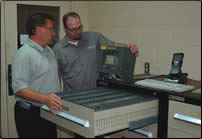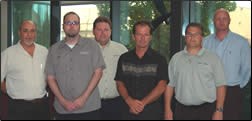Gear Manufacturer Gains Efficiency With Tool Management System
When producing a large number of complex, high-value-added parts, processes are continually examined and optimized, and this influences the style and numbers of cutting tools that are used each day. Avon Gear Company (Rochester Hills, Michigan) knows this first-hand.
Share




When producing a large number of complex, high-value-added parts, processes are continually examined and optimized, and this influences the style and numbers of cutting tools that are used each day. Avon Gear Company (Rochester Hills, Michigan) knows this first-hand.
The company specializes in producing precision-machined components and subassemblies for industrial equipment manufacturers. Its product line includes numerous styles of gears as well as shaft, housing and spline products of various configurations. Avon manufactures more than 600 part numbers in annual quantities ranging from 5 to 80,000 pieces.
Recently, the shop discovered that cost savings can present themselves in some surprising ways. Transitioning to a new tool management methodology enabled the gear manufacturer to increase productivity.
Avon originally began working with Curt Hassan, Seco Tools Inc.’s (Detroit, Michigan) automotive accounts manager. He introduced the company to Productivity Cost and Analysis (PCA) software, which is part of Seco Business Solutions line of value-added Point-of-Use solutions. PCA evaluates a process or workpiece as it moves through production to achieve a certain objective, such as reducing costs or increasing output. The user can evaluate a single machine tool process or the complete path that a workpiece takes on its journey through the shop floor.
“Typical results with PCA show reductions in tooling costs of more than 30 percent, with productivity improvements of 40 percent,” says Magnus Tillman, Seco Business Solutions’ program manager. “We felt confident that Avon could achieve similar numbers with our help.”
The company formerly had a tool management provider supplying tool vending machines, managing inventory and dispensing products. “Our existing system made it difficult for us to quickly implement the tooling and productivity changes recommended by Seco,” says Dave Share, general manager at Avon.
It was clear that the company needed to investigate other options. The company consulted Seco, which then consulted distributor E&R Industrial Sales (Sterling Heights, Michigan) as its program partner.
“Avon came to us and requested a proposal to handle everything—the tools, application support, tooling management and logistics,” Mr. Tillman says. “While we supervise the PCA and application support, we needed someone to handle the actual inventory and stocking.”
Under its existing tool program, the company had seven vending machines to manage inventory and dispense products. Initially, E&R replaced these machines with three smaller SecoPoint machines, all of which are powered by SupplyPro. With configurable “Smart Drawer” technology, the company was able to store more tooling in a smaller space. Although the “Smart Drawer” is designed to hold Seco’s products, it can accommodate virtually any manufacturer’s insert, as well as safety gloves, ear plugs, safety glasses and so on. The distributor also recommended a single insert dispenser (SID), which stores 20 individual inserts in separate compartments and distributes them one at a time. This new methodology accommodates 1,280 inserts per drawer versus 96 with the previous tooling storage system.
The glue that binds all of this together is the SupplyPort Web portal, the manufacturer says. All of the Seco Point-of-Use devices communicate with the portal to analyze inventory and consumption patterns on a daily basis. The device adjusts the minimum and maximum inventory levels to help the company reach its business objectives.
Avon was assigned a dedicated area of the Web portal, which is hosted at a secure data center. Employee Gerald Pitts was appointed as the program leader to manage the Point-of-Use system, stocking inventory on a daily basis and accessing and managing SupplyPort via the internet using a standard Web browser.
“I spend less than 1 hour per day managing inventory with the new system,” says Mr. Pitts. “I ran back and forth from the floor to the supply room three to four times daily to fulfill tooling needs with the previous method.”
According to the manufacturer, some supply processes either do not control the quantities issued or limit access to only certain items during a tool crib or storeroom transaction. This type of limitation can result in excessive usage and waste. However, with the Point-of-Use solutions, companies such as Avon can attain accountability and accuracy. Each dispense transaction is recorded, and inventory levels are adjusted appropriately. Each transaction includes the date and time dispensed, the employee number, the product, the quantity dispensed and customer-defined information such as work cell, job number or serial number.
“Working with Seco has changed our way of doing business,” Mr. Pitts says. “We were doing commodity management under our old program. Although we may have been paying a few cents less per insert, we were also buying more inserts than necessary. Because we couldn’t adjust the order data, we were frequently placing emergency tooling orders.”
“Some of our parts are in the machining process for 3 to 4 hours,” Mr. Share adds. “If you get down to the last operation and don’t have the correct tool, variations can occur. This can lead to scrap, making the job less profitable.”
“PCA has increased our productivity,” says Aaron Remsing, president at Avon. “It identifies the most economical way to produce a part. “For example, a PCA analysis performed on a bevel gear demonstrated that we could reduce our cycle time by 2.38 minutes per gear. As a result, we are able to get more parts out the door in less time. In addition to the savings in machine time, our tooling costs have decreased by almost 90 percent annually. Improvements like this allow us to keep more work in-house while maximizing our profitability.”
Related Content
Tips for Designing CNC Programs That Help Operators
The way a G-code program is formatted directly affects the productivity of the CNC people who use them. Design CNC programs that make CNC setup people and operators’ jobs easier.
Read MoreOrthopedic Event Discusses Manufacturing Strategies
At the seminar, representatives from multiple companies discussed strategies for making orthopedic devices accurately and efficiently.
Read MoreAutomated CAM Programming – Is Your Software Really Delivering?
A look at the latest automation tools in Autodesk Fusion 360 software and how forward-thinking machine shops and manufacturing departments are using them to slash delivery times and win more business.
Read MoreContinuous Improvement and New Functionality Are the Name of the Game
Mastercam 2025 incorporates big advancements and small — all based on customer feedback and the company’s commitment to keeping its signature product best in class.
Read MoreRead Next
Setting Up the Building Blocks for a Digital Factory
Woodward Inc. spent over a year developing an API to connect machines to its digital factory. Caron Engineering’s MiConnect has cut most of this process while also granting the shop greater access to machine information.
Read MoreRegistration Now Open for the Precision Machining Technology Show (PMTS) 2025
The precision machining industry’s premier event returns to Cleveland, OH, April 1-3.
Read More5 Rules of Thumb for Buying CNC Machine Tools
Use these tips to carefully plan your machine tool purchases and to avoid regretting your decision later.
Read More





















.jpg;maxWidth=300;quality=90)














